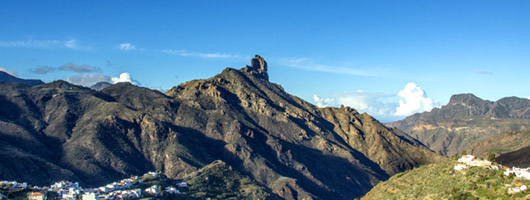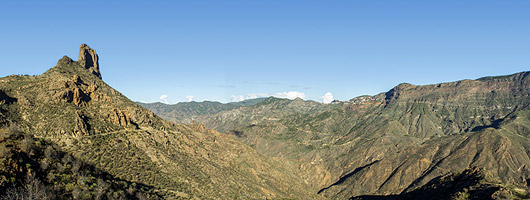In terms of landscape, quite a unique spectacle is afforded from this point: The Tejeda Ravine, known by many as the Big Ravine, viewed here from a central position, at the heart of the hydrographic basin.
D. Miguel de Unamuno described these rugged slopes as a <em>fossilised storm</em> when he set eyes on them, and they account for most of Gran Canaria’s geological history over 14 million years. As there have been no further eruptions over the last three million years on this part of the island, erosion has worn away the insides of the volcanic complex which had previously built up within.

From the depths, in the heart of the current erosive crater of Tejeda, the Roque Bentayga emerges. It represents a sacred place for the island’s original inhabitants, as the arqueological settlements that lie there testify. This landmark tops a series of crags that spread downwards from the Degollada de Las Moradas to the small settlement of El Roque, with Las Cuevas del Rey nestling in the middle, which also treasures important remains.
The ravines of El Chorrillo and Tejeda straddle both sides of the Roque Bentayga, and are the main ones that lead to Barranco Grande, along with the ravine of Siberio, which, at the foot of Mesa de los Junquillos, opens out into the reservoir of the same name.

Dotted around the area are small hamlets with traditional roof-tiled houses, which are nearly all used today as secondary holiday and weekend residences, with some of them remaining completely empty, such as La Higuerilla. El Espinillo, La Solana and El Chorrillo still have a small permanent population, basically devoted to farming and goat rearing for milk and cheese, constituting the staple diet of the locals.
The pine groves all around us are Canary pine. Along with the remains of the great original pine grove, newer trees have been added as part of a local reforestation programme.
This whole area forms part of the World Reserve of the Gran Canaria Biosphere, as declared by UNESCO on 29th June 2005.
